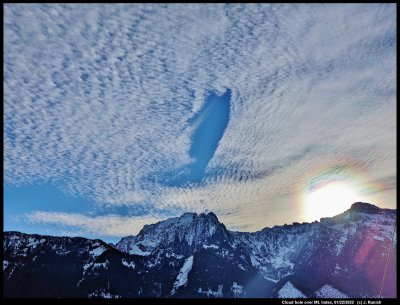| « The Snowflake’s Closest of Kin | Bright Tangent Arc After Sundown » |
Hole in Cloud
A region of thin, high cloud becomes ice, making a hole. That is what happened in the picture below.
See the blue hole over the mountain? It may not be circular, but it clearly is a gap where once had been cloud.
If you look at that cloud, you might not realize that it consists nearly entirely of droplets. How do I know that?
The (colored) corona around the sun at the bottom right is a diffraction effect that occurs in thin regions containing nearly uniform-sized droplets. The angular position of the colored rings is solely dependent on the ratio of wavelength to droplet size. So, by noting the color and the position of the ring, one can deduce the droplet size in that region of cloud. Right now, we don't care so much about the droplet size as the mere fact that they must be droplets.
However, the droplets are almost certainly all well below the freezing temperature (perhaps below -20 C), so if a droplet happens to freeze, the resulting crystal will grow rapidly. Growing rapidly, it will both dry out the neighboring air, which causes the surrounding drops to evaporate, and the crystal falls. It falls below the cloud, into drier air, and then it too evaporates (actually, we use the term 'sublimate' for solids, but the process is the same).
If you look near the top of the blue hole, you can see a thin wisp of cloud. That wisp consists of falling ice.
So, that explains why there is a hole, but we have to wonder--why did it happen there?
Well, it must have gotten just a little too cold there, perhaps below -30 C. The cloud layer was probably rising as it moved from right-side to left-side (west-to-east), and a wave was produced where the air went over the mountain ridge that you see. The extra rise in that location brought the droplets into higher, and colder, air where they quickly froze. The wave is invisible, but its effect is not.
--JN
1 comment

About the reason that the hole is in that particular location, I think a better explanation is that a plane passed through the cloud. These are known as “hole-punch clouds". As to the reason that a plane would produce the ice: the passing of the plane’s wings, body, and (if present) propellors, through the air produce a region in which the air expands. The expansion produces cooling, and the already plenty supercooled droplets are pushed below the homogeneous freezing temperature of -40 C. Hence, some freeze. The frozen ones grow rapidly at the expense of the remaining drops, and fall out.
